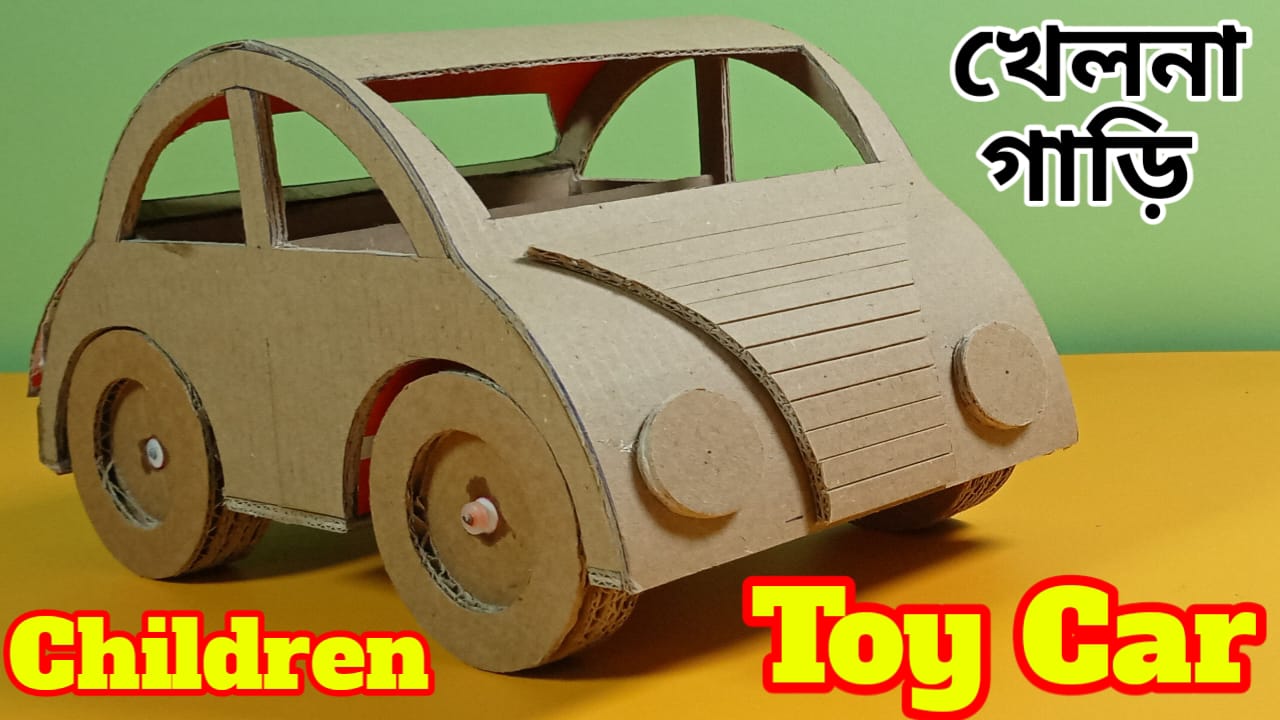DIY projects are a fantastic way to spark creativity and provide children with hours of entertainment. Making a toy car from cardboard is not only a fun activity but also a great opportunity to bond with your little ones. In this guide, we’ll explore step-by-step instructions on creating an amazing children’s toy car using readily available materials.

I. Introduction
A. DIY Toy-Making Popularity
In recent times, do-it-yourself (DIY) projects have gained immense popularity, especially those related to creating toys for children. This surge is fueled by the desire to encourage creativity and imaginative play in youngsters.
B. Importance of Creative Play
Creative play is crucial for a child’s development. It enhances problem-solving skills, promotes cognitive development, and nurtures a sense of accomplishment. Crafting a toy car from cardboard not only serves as a form of entertainment but also contributes to the overall growth of a child.
II. Materials Needed
A. List of Materials
To embark on this exciting DIY adventure, gather the following materials:
- Cardboard sheets
- Craft knife or scissors
- Non-toxic paints
- Brushes
- Glue or adhesive
- Wooden dowels for axles
- Small plastic bottle caps for wheels
B. Brief Description
Understanding the role of each material is vital. Cardboard provides the structure, paints add vibrancy, and wooden dowels and plastic caps ensure the toy’s functionality.
III. Planning Your Toy Car
A. Sketching the Design
Before diving into construction, sketch the desired design of the toy car. This initial planning step helps visualize the final product and ensures a smoother crafting process.
B. Considering Size and Safety
Keep the size of the toy appropriate for the child’s age. Ensure rounded edges to minimize the risk of injuries during playtime.
C. Selecting Color Schemes
Choosing appealing color schemes adds a personal touch to the project. Let your child’s preferences guide the selection of colors for a truly customized toy.
IV. Step-by-Step Construction
A. Cutting and Shaping
Carefully cut and shape the cardboard according to the sketched design. Take your time to create precise pieces that fit together seamlessly.
B. Assembling the Main Structure
Glue the cardboard pieces together to form the main structure of the toy car. Allow sufficient drying time to ensure a sturdy build.
C. Adding Wheels and Axles
Insert wooden dowels through the cardboard for axles and attach plastic bottle caps as wheels. This step brings the toy car to life.
D. Painting and Decorating
Let creativity flow as you paint and decorate the toy car. Involve your child in this step to make the process even more enjoyable.
Make Amazing Children Toy Car by Cardboard
V. Safety Measures
A. Non-Toxic Materials
Prioritize non-toxic materials to guarantee the safety of your child during play. Check paint labels for child-friendly and washable options.
B. Smooth Edges and Secure Assembly
Ensure all edges are smooth to prevent scratches. Double-check the assembly for any loose parts that could pose a choking hazard.
C. Supervision During Playtime
While the toy car is a handmade creation, supervision during play is essential, especially for younger children.
VI. Benefits of DIY Toy-Making
A. Encourages Creativity
DIY projects encourage creativity and allow children to express themselves through art and play. The toy car becomes a canvas for their imagination.
B. Fosters a Sense of Accomplishment
Completing a DIY project instills a sense of accomplishment in children, boosting their confidence and self-esteem.
C. Promotes Sustainability
Crafting toys from cardboard promotes sustainability by repurposing materials and reducing waste.
VII. Customization Ideas
A. Adding Special Features
Take the customization a step further by adding special features like headlights, a steering wheel, or even a personalized license plate.
B. Incorporating Themes
Consider incorporating themes based on your child’s interests, whether it’s animals, superheroes, or their favorite colors.
VIII. Sharing the Experience
A. Creating a Fun Family Activity
Involve the whole family in the DIY process. It becomes a memorable bonding experience that everyone can cherish.
B. Documenting the Process
Capture the joy of creation by taking photos or recording videos of the crafting journey. Share these moments with friends and family.
IX. Troubleshooting Tips
A. Common Challenges
Anticipate common challenges during construction, such as difficulty in shaping cardboard. Prepare solutions in advance to overcome these hurdles.
B. Solutions to Difficulties
Provide practical solutions to address difficulties, ensuring readers feel supported and confident in their DIY endeavor.
X. Personalizing the Toy Car
A. Adding Personal Touches
Encourage readers to add personal touches like the child’s name or favorite colors to make the toy car truly unique.
B. Making It Special
Highlight the significance of personalization in creating a one-of-a-kind toy that holds sentimental value.
XI. Storage and Maintenance
A. Tips for Storage
Offer practical tips on storing DIY cardboard toys to prolong their lifespan and keep them in good condition.
B. Repairing Minor Damages
Guide readers on simple methods to repair minor damages, extending the longevity of their handmade creations.
XII. Showcasing Your Creations
A. Displaying the Finished Toy Car
Celebrate the completion of the project by displaying the finished toy car prominently. This showcases the achievement and creativity involved.
B. Sharing on Social Media
Encourage readers to share their creations on social media platforms, fostering a community of DIY enthusiasts.
XIII. Encouraging Others to DIY
A. Inspiring Others
Share personal anecdotes or success stories to inspire others to embark on their own DIY journeys. Highlight the joy of creating something with one’s hands.
B. Joy of Handmade Creations
Reflect on the joy and satisfaction that come from handmade creations, especially in a digital age where instant gratification is prevalent.
XIV. Conclusion
A. Recap of Benefits
In conclusion, creating an amazing children’s toy car from cardboard brings numerous benefits, including fostering creativity, providing a sense of accomplishment, and promoting sustainability.
Thank you very much visiting for websitehttps://creativitytopper.com
